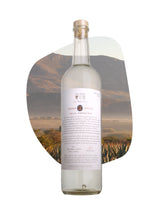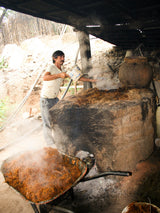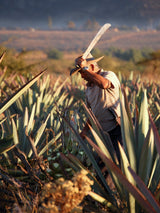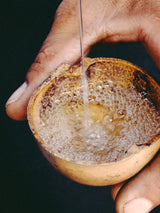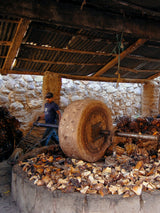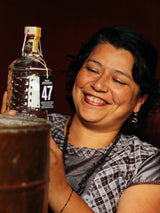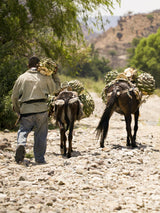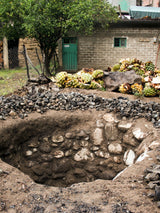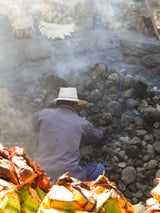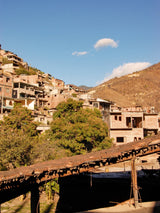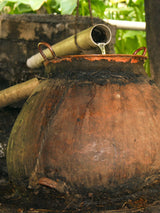

Método Antiguo
Método Antiguo honors the “old way” of producing mezcal that only stopped about 10 years ago due to regulatory constraints. In this method, the tails from the first distillation are used to “bring down” (dilute the alcoholic content of) the body of the second distillation. This method adds complexity and various fruity and vegetal notes to the final product.

Agave Espadín
the best mezcals come from fully mature agaves. These are from a field near Santiago Matatlan, a.k.a. the “World Capital of Mezcal”.

Xicara Tasting
Prior to government regulation of mezcal, you would typically visit a family distillery and taste what the mezcalero had to offer, Whe you chose one, it would be at still proof, and the mezcalero would dilute it to your taste with the tails from a first run. You can judge the alcohol percent of good mezcal by pouring it into a sipping cup (traditionally a xicara = half of a small gourd) and checking the number and size of the perlas (bubbles).


Gifted Mezcalera
Karina Abad, Head of Production, has worked closely with dozens of family distilleries and has an exceptionally wide knowledge of agaves and methods of distilling. Trained as a lab chemist, she infuses her practical expertise in distillation with a technical understanding of the process. She personally distilled the Método Antiguo

Ancestral Methods
The production for artisanal mezcal often feel like a throwback to the preindustrial times. Donkeys are used not just for transport, but also to drive the mill that crushes the roasted agave piñas. These hand methods allow the final products to remain distinct in character and full of life.






Método Antiguo
Método Antiguo honors the “old way” of producing mezcal that only stopped about 10 years ago due to regulatory constraints. In this method, the tails from the first distillation are used to “bring down” (dilute the alcoholic content of) the body of the second distillation. This method adds complexity and various fruity and vegetal notes to the final product.

Agave Espadín
the best mezcals come from fully mature agaves. These are from a field near Santiago Matatlan, a.k.a. the “World Capital of Mezcal”.

Xicara Tasting
Prior to government regulation of mezcal, you would typically visit a family distillery and taste what the mezcalero had to offer, Whe you chose one, it would be at still proof, and the mezcalero would dilute it to your taste with the tails from a first run. You can judge the alcohol percent of good mezcal by pouring it into a sipping cup (traditionally a xicara = half of a small gourd) and checking the number and size of the perlas (bubbles).


Gifted Mezcalera
Karina Abad, Head of Production, has worked closely with dozens of family distilleries and has an exceptionally wide knowledge of agaves and methods of distilling. Trained as a lab chemist, she infuses her practical expertise in distillation with a technical understanding of the process. She personally distilled the Método Antiguo

Ancestral Methods
The production for artisanal mezcal often feel like a throwback to the preindustrial times. Donkeys are used not just for transport, but also to drive the mill that crushes the roasted agave piñas. These hand methods allow the final products to remain distinct in character and full of life.




Los Nahuales Mezcal Método Antiguo
The método antiguo, the old way of producing good mezcal, is to use the tails from the first distillation to “bring down” (dilute the alcoholic content of) the body of the second distillation. The body of the second distillation run is normally at some 54-55%, and with the método antiguo it is brought down to drinking strength by dilution using the tails cut (codas) from the first distillation run (normally at 10-13%). The original NORMA regulations governing mezcal made for export forbade this practice, and thus all exported mezcals that dilute for bottling started using water.
It takes quite a bit of tails to dilute, for example, from 54% to 48%, and the addition brings in beautiful fresh flowery esters and considerable added complexity. By returning to the método antiguo, we bring back to life, and restore the former quality of, the finest artisan mezcals.

Identical twins Jaimé and Gustavo Muñoz own five restaurants, including the well-known Los Danzantes in Oaxaca city. They present regional Mexican cuisine on international standards, emphasizing authentic ingredients. In 1997, they purchased a small distillery in Santiago Matatlan, an artisan distilling center near Oaxaca city, to create a dependable supply of high-quality mezcal for their restaurants.
In 2004, they hired Hector Vasquez de Abarca in to run the Los Danzantes distillery. Hector developed an inventive mix of traditional methods and intelligent innovations. In 2009, Karina Abad Rojas, a trained lab chemist, took over, and has overseen the expansion of the distillery. Los Danzantes and Alipus together are Mexico’s leading artisan mezcals; in 2013, President of Mexico Enrique Peña Nieto awarded Grupo Los Danzantes the annual National Quality Award.
Knowledgeable persons regard Los Danzantes/Los Nahuales as the finest mezcal in regular production.
Los Nahuales mezcal is distilled at the Déstileria Los Danzantes in Santiago Matatlan, the world capital of mezcal, south of Oaxaca city. The mezcals are branded as Los Nahuales in the USA due to trademark issues.
_________________
Without exception, our goods are sold in the State of California, and title passes at purchase to the buyer in California. No representation is made as to the legal rights of anyone to ship to or import into any state other than California. The buyer is solely responsible for shipment to states outside California. By placing an order, the buyer authorizes Rarestill to act on his/her behalf to engage a common carrier to deliver his/her order to buyer.
Please read the information below carefully, especially if your purchase is a gift.
ALCOHOLIC BEVERAGES MAY BE SOLD AND DELIVERED ONLY TO PERSONS WHO ARE AT LEAST 21 YEARS OLD. IN PLACING YOUR ORDER, YOU REPRESENT TO US THAT YOU ARE AT LEAST 21 YEARS OLD AND THAT THE PERSON TO WHOM YOU ARE DIRECTING DELIVERY IS ALSO AT LEAST 21 YEARS OLD.
When your goods are delivered, the person receiving delivery may be required to show identification proving that he or she is at least 21 years old.
All sales made on this website will be deemed to have taken place in Ukiah, CA, and sales taxes will be assessed based on that location.


Método Antiguo
Método Antiguo honors the “old way” of producing mezcal that only stopped about 10 years ago due to regulatory constraints. In this method, the tails from the first distillation are used to “bring down” (dilute the alcoholic content of) the body of the second distillation. This method adds complexity and various fruity and vegetal notes to the final product.

Agave Espadín
the best mezcals come from fully mature agaves. These are from a field near Santiago Matatlan, a.k.a. the “World Capital of Mezcal”.

Xicara Tasting
Prior to government regulation of mezcal, you would typically visit a family distillery and taste what the mezcalero had to offer, Whe you chose one, it would be at still proof, and the mezcalero would dilute it to your taste with the tails from a first run. You can judge the alcohol percent of good mezcal by pouring it into a sipping cup (traditionally a xicara = half of a small gourd) and checking the number and size of the perlas (bubbles).


Gifted Mezcalera
Karina Abad, Head of Production, has worked closely with dozens of family distilleries and has an exceptionally wide knowledge of agaves and methods of distilling. Trained as a lab chemist, she infuses her practical expertise in distillation with a technical understanding of the process. She personally distilled the Método Antiguo

Ancestral Methods
The production for artisanal mezcal often feel like a throwback to the preindustrial times. Donkeys are used not just for transport, but also to drive the mill that crushes the roasted agave piñas. These hand methods allow the final products to remain distinct in character and full of life.






